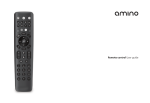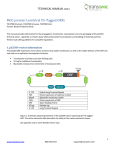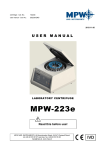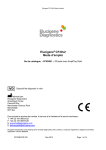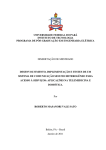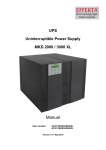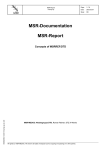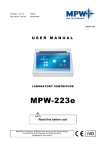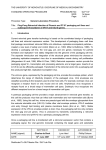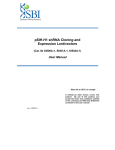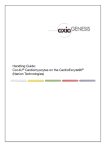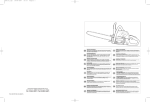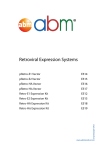Download PLATINUM Select MLP Retroviral shRNA-mir
Transcript
PLATINUM Select MLP Retroviral shRNA-mir TRH1000, TRM1001, TRHS1000, TRMS1001, TRHK1000, TRMK1001, TRH5000, TRM5000 Overview PLATINUM Select MLP Retroviral microRNA-adapted short hairpin RNA (shRNA-mir) are next generation vector-based RNAi triggers generated using the proprietary shERWOOD Algorithm developed in Dr. Greg Hannon’s laboratory at Cold Spring Harbor Laboratories. Based on the functional testing of 270,000 shRNA sequences using a high-throughput sensor assay (Fellman et al 2011 and unpublished data) the shERWOOD algorithm has been trained to select shRNAmir designs that are rare and consistently potent even at single copy representation in the genome. The new SHERWOOD algorithm predicted sequences have been applied to the creation of new PLATINUM Select MLP Retroviral shRNA-mir collections targeting human, mouse and rat genomes. Platinum Select MLP Retroviral shRNA-mir collections are available as individual constructs, target gene sets, gene families as well as pathways and genome libraries. Table 1: shRNA-mir clone formats available Format Description Cat # Individual clones Human retroviral shRNA-mir Mouse retroviral shRNA-mir TRH1000 TRM1001 Target gene set: 3-4 clones targeting a gene Human retroviral shRNA-mir Mouse retroviral shRNA-mir TRHS1000 TRMS1001 Starter kit: 3-4 clones targeting a gene, controls and transfection reagent Gene families and pathway sets Human retroviral shRNA-mir Mouse retroviral shRNA-mir TRHK1000 TRMK1001 Human retroviral shRNA-mir TRH3004, TRH3006, TRH3007, TRH3010, TRH3005, TRH3001, TRH3002, TRH3003 Genome library Human retroviral shRNA-mir TRH5000 Mouse retroviral shRNA-mir TRM5000 Table 2: shRNA-mir clone formats available The information and protocols contained in this manual have been developed for the use of all the above formats. www.transomic.com 866-833-0712 1 [email protected] shRNA-mir design and vector information PLATINUM Select shRNA-mir have the following characteristics: Hairpin design shRNA-mir sequences are embedded in a primary microRNA-30 context so as to undergo processing via the endogenous microRNA pathway, which has been shown to minimize competition with endogenous microRNAs by the exogenous sequences (Castanotto 2007). Simple stem loop hairpins have been shown to be disruptive to normal microRNA function and processing while microRNA-adapted shRNA (shRNA-mir) display reduced toxicity and off-target effects when compared with simple stem loop hairpin sequences. (Grimm et al. 2006, McBride et al. 2008, Beer et al. 2010, Pan et al. 2011). The shRNA-mir expression cassette consists of a 22-nucleotide target-gene-specific sequence, a 19-nucleotide loop, and another 22-nucleotide reverse complementary sequence, thus forming a hairpin. shERWOOD algorithm designs have been created per target gene according to the following criteria: • Hairpin sequences target the coding regions of Refseq annotated genes. • Multiple transcript genes were targeted by designs that spanned across all transcripts. In the few cases (less than 0.5%) where there was insufficient sequence design space that spanned across all transcripts - each transcript has a separate design. pMLP vector information The pMLP shRNA-mir expression vector has a number of features allowing both transient and stable transfection; as well as the stable delivery of the shRNA-mir expression cassette into host cells via a replication-incompetent retrovirus. The shRNA-mir expression cassette; sense, loop and antisense elements are all under the control of the viral LTR promoter. The shRNA-mir sequences have been cloned in to the pMLP vector, which has the following characteristics: • MSCV-based retroviral vector for delivery and expression in most mammalian cell lines including murine or human hematopoietic and embryonic stem (ES) cells. • shRNA-mir constructs are expressed from the retroviral LTR promoter. • The ability to select stable integrants using puromycin selection. • TurboGFP serves as a marker for retroviral integration. The pMLP vector contains both 5’ and 3’ LTRs of MSCV. Upon transfection of the plasmids into a packaging cell line, replication-incompetent high titer virus can be obtained and used to infect target cells. The pMLP vector is identical to the Murine Stem Cell Virus (MSCV) vectors derived from the Murine Embryonic Stem Cell Virus (MESV) and the LN retroviral vectors (Hawley et al. 1994, Grez et al. 1990, Miller and Rosman 1989). Once transfected or transduced in to the experimental cell line, the pMLP vectors achieve stable, high-level gene expression in hematopoietic and embryonic stem cells through a specifically designed 5' long terminal repeat (LTR). This LTR is from the murine stem cell PCMV www.transomic.com 866-833-0712 2 [email protected] virus, and it differs from the MoMuLV LTR used in other retroviral vectors by several point mutations and a deletion. These changes enhance transcriptional activation and prevent transcriptional suppression in embryonic stem and embryonal carcinoma cells. As a result, the LTR drives high-level constitutive expression of the shRNA-mir transcript in stem cells or other mammalian cell lines. The murine phosphoglycerate kinase (PKG) promoter controls expression of the puromycin resistance gene (Puromycin resistance) for antibiotic selection in eukaryotic cells. pMLP also contains the pUC origin of replication and E. coli Ampicillin resistance gene for propagation and antibiotic selection in bacteria. The unique sequence specificity of the potent, mir-based PLATINUM Select shRNA-mir; placed in the versatile, efficient pMLP retroviral vector, provides a highly successful method to knock down a gene of interest either transiently or stably to allow gene function analysis at a new and improved level. 5’ LTR miR 30 flanks PGK Puro IRES TurboGFP 3’ LTR Ψ+ Beta-lactamase pUC Ori Modified MSCV LTR for enhanced expression Create a natural substrate for microRNA processing Strong promoter across many cell lines Mammalian selection marker Internal ribosomal entry site Fluorescent marker with high photostability Transcriptional stop Viral packaging signal Ampicillin antibiotic resistance genes High-copy origin of replication for propagation in E. coli Figure 1: Cartoon depicting elements of the pMLP vector containing the shRNA-mir sequence. The vector elements table describes the utility of the various elements shown. See appendix 1 for a more detailed vector map. www.transomic.com 866-833-0712 3 [email protected] Replication protocols Materials for individual and plate replication Catalog # LB-Lennox Broth (low salt) Glycerol Carbenicillin 96-well plates Aluminum seals Disposable replicators VWR EM1.00547.0500 VWR EM-4760 VWR 97063-144 VWR 62407-174 VWR 29445-082 Genetix X5054 Grow all pMLP retroviral shRNA-mir clones at 30°C for 30 hours or until even growth is observed in all wells. Autoclave broth to sterilize and allow cooling to 60°C before adding the antibiotic. Individual shRNA-mir clones E. coli carrying pMLP retroviral shRNA-mir are best propagated in LB broth or LB broth 8% glycerol for freezing. 1. Grow the shRNA-mir clone culture in LB broth with the ampicillin or carbenicillin (100 μg/ml). 2. 2-10 ml starter cultures for plasmid purification can be inoculated using 2 to 10 µl. Alternatively 1. Pick a single starter colony from a freshly streaked LB agar plate containing the antibiotic and inoculate into the desired volume of LB broth for plasmid purification. 2. Grow for 30 hours at 30°C for with vigorous shaking (~300 rpm). Replication of plates Prepare target plates by dispensing ~200 μl of LB-Lennox media supplemented with 8% glycerol and 100 μg/ml carbenicillin. If a lower-volume 96-well plate is substituted, then fill each well ~50% with media. Glycerol can be omitted from the media if you are culturing for a plasmid DNA extraction. Prepare source plates 1. Remove foil seals while the source plates are still frozen. This minimizes crosscontamination. 2. Wipe any condensation underneath the lid with a paper wipe dampened with ethanol. 3. Thaw the source plates with the lid on. Replicate 1. Gently place a disposable replicator in the thawed source plate and lightly move the replicator around inside the well to mix the culture. Make sure to scrape the bottom of the plate of the well. www.transomic.com 866-833-0712 4 [email protected] 2. Gently remove the replicator from the source plate and gently place in the target plate and mix in the same manner to transfer cells. 3. Dispose of the replicator. 4. Place the lids back on the source plates and target plates. 5. Repeat steps 1-4 until all plates have been replicated. 6. Return the source plates to the -80°C freezer. 7. Place the inoculated target plates in a 30°C incubator for 30 hours or until even growth is observed in all wells. Minimize thawed condition of plates where possible. Always store plates at -80°C. It is recommended that an archival copy is made as soon as possible. Glycerol stocks kept at -80°C are stable indefinitely as long as freeze/thaw cycles are kept to a minimum. Plasmid preparation For transfection and transduction (infection) experiments the pMLP plasmid DNA will first have to be extracted from the bacterial cells. When transforming directly into an experimental cell line, either a standard plasmid mini-preparation can be used or one that yields endotoxin free DNA. When extracting plasmid DNA to make virus for transduction, more DNA is required and using and endotoxin free kit will generally yield higher viral titers Restriction digest To carry out a diagnostic restriction digest on pMLP retroviral shRNA-mir vectors it is recommended that the plasmid is digested with NcoI. NcoI cuts pMLP three times on either side of the LTRs to generate three bands of 423bp, 3618bp and 3761bp in length. Digest approximately 500ng of plasmid and allow the reaction to proceed for 3 hours. Load half the digestion mixture on a 0.7% gel to visualize the resultant bands. 1 2 3 4 5 6 7 NEB TriDye 2-log DNA Ladder Sample 1 uncut Sample 2 cut (NcoI) Sample 3 uncut Sample 4 cut (NcoI) Sample 5 uncut Sample 6 cut (NcoI) Figure 2: Agarose gel (0.7%) depicting pMLP samples contain shRNA-mir undigested or digested with NcoI www.transomic.com 866-833-0712 5 [email protected] Puromycin selection (puromycin kill curve) The pMLP retroviral vector has a puromycin resistance marker for selection in mammalian cells. To establish stable cell lines, once transfection/transduction has occurred, the cells can be placed on puromycin to select for stable integrants. Since each cell line potentially has a different sensitivity to puromycin, the optimal concentration of puromycin (pretransfection/transduction) should be determined. Below is the protocol for titrating puromycin (kill curve), using as an example a 24 well tissue culture dish. 1. Prepare appropriate cell culture media and puromycin dilutions for antibiotic titration. Using a stock solution of puromycin (1.25µg/µl stock recommended) make dilutions in the media of the antibiotic ranging from 0 to 10 µg/ml (final concentration) in 0.5µg/ml increments. Table 3: Dilutions and volumes required for establishing optimal puromycin concentration Volume of Puromycin Stock Solution Added (µl) 0 0.2 0.4 0.6 0.8 1 1.2 1.6 2 3 4 Total Volume of Media plus Antibiotic per 24 Well 500 µl 500 µl 500 µl 500 µl 500 µl 500 µl 500 µl 500 µl 500 µl 500 µl 500 µl Final Concentration (µg/ml) 0 0.5 1 1.5 2 2.5 3 4 5 7.5 10 2. Split/dilute cells from a confluent well of a 24 well plate (~ 5 x 104 cells per 500µl media). 3. Plate ~ 5 x 104 cells per well in media without puromycin and allow enough time for cells to attach (less than 24 hours for most cell lines) before adding antibiotic. 4. Begin antibiotic selection the following day by replacing with media containing the appropriate concentrations of puromycin (see Table 3). 5. Incubate cells at 37°C, or use conditions normal for your target cells. 6. Observe the cells for approximately 7 days. 7. Replace the media every 3 days with media containing the correct puromycin concentration for each well. 8. To minimize duration to achieve fully selected stable, cell populations one should choose the lowest concentration of drug that begins to give substantial cell death in 3 days and kills 100% of the cells within 5 days. www.transomic.com 866-833-0712 6 [email protected] Transfection OMNIfect transfection reagent for delivery of plasmid DNA Use the following procedure to transfect plasmid DNA into mammalian cells in a 24-well format. For other plate formats, scale up or down the amounts of DNA and OMNIfect reagent proportionally to the total transfection volume (Table 4). Adherent cells: One day before transfection, plate 80,000 cells/well in 500 μl of growth medium without antibiotics so that cells will be 70–95% confluent at the time of transfection. Suspension cells: On the same day of transfection just prior to preparing transfection complex plate 160,000/well cells in 500 μl of growth medium without antibiotics. Transfection complex preparation (Figure 3): Volumes and amounts are for each well to be transfected. 1. Plasmid DNA preparation: Dilute 0.5 µg of plasmid DNA in a microfuge tube containing Opti-MEM® I Reduced Serum Media*** up to a total volume of 25 µl. 2. OMNIfect reagent preparation: In a separate microfuge tube, add 1 µL of OMNIfect into 24 µl Opti-MEM® I Reduced Serum Media*** for a total volume of 25 µl. 3. Final transfection complex: Transfer the diluted DNA solution to the diluted OMNIfect reagent (total volume = 50 µl). Mix gently and incubate at room temperature for 10 minutes. Adding transfection complex to wells: 1. Add the 50 µl of transfection complex to each well containing cells and medium. 2. Incubate cells at 37°C in a CO2 incubator for 24-48 hours. 3. After 24-48 hours of incubation, assay cells for gene activity. *** serum-free DMEM medium can also be used. www.transomic.com 866-833-0712 7 [email protected] Figure 3: Transfection protocol for 24 well plates (volumes indicated are per well). To transfect the entire plate multiply all volumes and DNA amount by 24. Table 4: Suggested amounts of DNA, medium and OMNIfect for transfection of plasmid DNA into adherent and suspension cells. Tissue Culture Plates Surface Area per Well (cm2) µl Plating Medium per Well 6- well 9 2000 µg Plasmid DNA per Well µl OMNIfect per Well µl Transfection Complex per Well† 2 4 200 (in 100 µl (in 100 µl Opti-MEM® I) Opti-MEM® I) 12-well 4 1000 1 2 100 (in 50 µl (in 50 µl Opti-MEM® I) Opti-MEM® I) 24-well 2 500 0.5 1 50 (in 25µl (in 25µl Opti-MEM® I) Opti-MEM® I) 96-well 0.3 200 0.1 0.2 10-20 (in 10µl (in 10µl Opti-MEM® I) Opti-MEM® I) † Total volume of the transfec-on complex is made up of equal parts of DNA solution and OMNIfect solution. www.transomic.com 866-833-0712 8 [email protected] Optimizing your transfection: It is important to optimize transfection conditions to obtain the highest transfection efficiency with lowest toxicity for various cell types. The optimal ratio of OMNIfect to DNA is relatively consistent across many cell types. For further optimization try the following steps in order. 1. Use the recommended ratio of DNA: transfection reagent (at 1 μg DNA:2 μl OMNIfect), but vary the volume. a. Start with a range of volumes that cover +20% to -20%. For example, in a 24-well plate a range of 40 μl to 60 μl of transfection complex would be added to the well. (The plating media would remain the same.) 2. If further optimization is needed, transfection efficiency and cytotoxicity may be altered by adjusting the ratio of DNA (μg) to OMNIfect reagent (μl). A range of ratios from 1:1.5 to 1:2.5 is recommended. Note: If transfection conditions result in unacceptable cytotoxicity in a particular cell line the following modifications are recommended: 1. Decrease the volume of transfection complex that is added to each well. 2. Higher transfection efficiencies are normally achieved if the transfection medium is not removed. However, if toxicity is a problem, aspirate the transfection complex after 6 hours of transfection and replace with fresh growth medium. 3. Increase the cell density in your transfection. 4. Assay cells for gene activity 24 hours following the addition of transfection complex to cells. Puromycin selection of transfected cells 1. After 24-72 hours of incubation, examine the cells microscopically for TurboGFP expression. a. Note: When visualizing TurboGFP expression, if less than 90% of all cells are green, it is recommended in these cases to utilize puromycin selection in order to reduce background expression of your gene of interest from untransfected cells. b. The working concentration of puromycin varies between cell lines. We recommend you determine the optimal concentration of puromycin required to kill your host cell line prior to selection for shRNAmir transfectants (see puromycin selection protocol). Typically, the working concentration ranges from 1-10 µg/ml. You should use the lowest concentration that kills 100% of the cells in 1-4 days from the start of puromycin selection. 2. If selecting for stably transfected cells (optional), change the medium on the cells to that containing puromycin for selection. It is important to wait at least 24 hours before beginning selection. 3. Begin the antibiotic selection by replacing the medium with complete medium supplemented with the optimal puromycin concentration. Incubate. www.transomic.com 866-833-0712 9 [email protected] 4. Approximately every 2-3 days replace with freshly prepared selective media. Monitor the cells daily and observe the percentage of surviving cells. At some time point almost all of the cells surviving selection will be harboring the shRNA-mir construct. Optimum effectiveness should be reached in 3-6 days with puromycin. Observe the cells for approximately 7 days until you see single colonies surviving the selection. The negative control should have no surviving cells. Packaging retrovirus Using the recommended packaging system (See the Recommended Packaging System section), pMLP and an env expressing vector are cotransfected into the GP2-293 Packaging Cell Line. gag and pol genes, which are necessary for viral replication, are integrated and stably expressed from the packaging cell line genome. While all of the components needed to produce virus are present in the packaging cell during this process, only the RNA from the pMLP vector is packaged into the viral particles and transferred to the target cell. These viral particles are capable of transduction, however without the ability to express the gag, pol or env genes they are incapable of producing new viral particles in the targeted cells. These are referred to as replication-incompetent retroviral particles. Separating the essential viral structural genes during the packaging process ensures a high level of safety by limiting the opportunities for recombination during cell division and thereby minimizing the chance of producing replication competent virus. Examples of similar packaging systems or those where the gag and pol are provide in cis-acting plasmids are referenced here Mann et al. 1983, Miller and Buttimore 1986, Morgenstern and Land 1990, Miller and Chen 1996. Note: The viral supernatants produced by this retroviral vector could, depending on your cloned insert, contain potentially hazardous recombinant virus. Due caution must be exercised in the production and handling of recombinant retrovirus. Appropriate NIH, regional, and institutional guidelines apply. www.transomic.com 866-833-0712 10 [email protected] Figure 4: Schematic depicting retroviral packaging of pMLP retroviral vectors A retroviral transfer vector (pMLP) is co-transfected with the desired helper vector encoding the env protein into a packaging cell line. The gag and pol genes, essential for virus production, are stably integrated into the cell line’s genome and constitutively expressed. gag, pol and env provide the proteins necessary for viral assembly and integration. The transfer vector contains the shRNA-mir and selection cassette that will integrate into the target cell’s genome. Viral particles are released from the packaging cell and can be harvested from the supernatant of the packaging cell. This virus can be concentrated or used as is. www.transomic.com 866-833-0712 11 [email protected] Recommended Packaging System The pMLP retroviral shRNA-mir vector can be packaged and viral particles produced in 48 hours using commercially available packaging kits. The Retro-XTM Universal Expression System from Clontech (Cat. No. 631530) has been shown to produce high titer virus with the pMLP retroviral vector . The packaging system provides GP2-293 Packaging Cell Line and all four commonly used envelopes on separate vectors (VSV-G, eco, ampho and 10A1) to allow you to choose the tropism that is most appropriate for your target cells. In combination with the Retro-X Concentrator (Cat. No. 7 631455/6) titers of 1 x 10 can be achieved. Retro-X Packaging kits and Concentrator can be purchased directly from transOMIC technologies. For more information see : http://transomic.com/Delivery-and-Packaging Supporting data for Retro-XTM Universal Expression System Three KRAS Platinum Select shRNA-mir and a negative control (shRNA-mir against firefly luciferase) were packaged into VSV-G pseudotyped retrovirus particles using the Retro-X Universal Packaging System (Cat# 631530). Crude retroviral supernatants, as well as supernatants concentrated using Retro-X Concentrator (Cat#631455/6), were titered to determine colony forming units (CFU) by puromycin selection or infectious units (IFU) by green fluorescence (FACS). Average titers for unconcentrated virus were 2.8x105 CFU/ml and 4.7x106 IFU/ml. While both methods are considered to be functional titers, variations in expression of turboGFP or puromycin can cause differences in the titer. The average difference between the two titrations is typical for these methods. Concentration of the retroviral supernatants resulted in a 10-fold average increase in titer for a 20X volume concentration. Concentration can be magnified if the fold volume change is increased. The final concentrated titer was 2.96x106 on puromycin selection and 4.5x107 IFU/ml. Packaging shRNA-mir viruses While viruses carrying shRNAs are packaged almost identically to viruses carrying proteinencoding genes, one point is worth noting. Since the host RNAi biogenesis machinery efficiently cleaves shRNAs, this can reduce the level of viral genomic RNAs and consequently viral titers. Therefore, one can enhance titers by co-transfecting the viral plasmid with a siRNA targeting a core microRNA biogenesis component, DGCR-8/Pasha. The following siRNA has been shown to be effective in increasing titers by several fold. Pasha siRNA - CGGGTGGATCATGACATTCCA, dXdY overhang, all annealed, no modification Safety and handling of retroviruses The protocols in this user manual require producing, handling, and storing infectious retrovirus. A thorough understanding of safe laboratory practices and potential retroviral hazards is essential. MSCV does not naturally infect human cells; however, viruses packaged from the MSCV-based www.transomic.com 866-833-0712 12 [email protected] vectors are capable of infecting human cells if packaged in system with the correct tropism. The viral supernatants produced by these retroviral systems could, depending on your retroviral insert, contain potentially hazardous recombinant virus. For these reasons, exercise due caution when producing and handling recombinant retrovirus. Appropriate NIH, regional, and institutional guidelines apply, as well as specific guidelines for other countries. Contact your on-site safety officer for specific requirements. In the United States, NIH guidelines require that retroviral production and transduction be performed in a Biosafety Level 2 (BL2) facility. A brief description of BL2 is given below. More information about BL2 guidelines is available in Appendix 4. Practices • Perform work in a limited access area • Post biohazard warning signs • Minimize production of aerosols • Decontaminate potentially infectious wastes before disposal • Take precautions with sharps Safety equipment • Use a laminar flow hood with a HEPA filter • Wear protective laboratory coat, face protection, and double gloves Facilities • Autoclave for decontamination of solid and liquid waste • Use un-recirculated exhaust air • Stock chemical disinfectants for spills Establishing viral titers Establishing viral titers is an important step in optimizing an experiment. Knowing the viral titers allows you to do the following: 1. Determine the efficiency of the packaging procedure. 2. Optimize conditions for infection of your target cell line. a. Infection efficiency differs based on target cell line and media. 3. Determine the number of cells that can be infected with your current stock of virus. Recommendations for titering pMLP shRNA-mir retroviral particles When measuring the amount of virus you have produced it is important to understand the different methods for measuring the titer. Physical titers measure the presence of viral proteins. These methods are often fast, but detect functional and non-functional viral particles. Methods that measure only those viral particles that can integrate and express in a target cell are more accurate and are referred to as functional titers. www.transomic.com 866-833-0712 13 [email protected] The pMLP vector includes two markers for functional titers. TurboGFP expression can be measured with fluorescent microscope or FACS analysis or colonies can be counted following puromycin selection. Functional titers may differ depending on the method used to confirm integration of the virus. For example, cell lines that are particularly sensitive to puromycin selection maybe turboGFP positive but die during puromycin selection. Therefore, for the most precise functional titer we recommend using the selection method that will be adopted in your experiment. Transduction mammalian cells with MLP retroviralshRNA-mir viral particles Reagents Cell line to be infected Appropriate culture media Polybrene solution Tissue culture plates and plastic-ware Polybrene solution Suspend 8 mg Hexadimethrine Bromide into 1ml H2O for an 8mg/ml stock Filter through 0.2um syringe filter Equipment Tissue culture incubators Platform rocker Low-speed centrifuge and adapters that can hold multi-well plates or desired culture plates Method General considerations: Growth media of the target cell can affect transduction efficiency if it is differs from that of the packaging cell line. Here, the investigator should experiment with exchanging the media on the packaging cells with that used for the target cell type 12 hours before virus harvest. Alternatively, the target cells might remain unaffected by a brief exposure to virus-containing media while still being infected efficiently. The method is given for 10 cm plates. Infection can be carried out in any standard tissue culture vessel, scaling all amounts based upon surface area. www.transomic.com 866-833-0712 14 [email protected] Prepare cells 1. Cells should be plated at least one day prior to infection such that they are 60-70% confluent at the time of initial virus exposure. The optimal density can vary for different cell lines and should be determined empirically. a. Note: Most cell lines require 12-24 hours to recover after plating for optimal infection efficiency. This is thought to be in part due to loss of cell surface receptors, used by the virus, during the trypsinization step when recovering adherent cell lines. 2. Exchange medium 3-4 hours prior to infection. Infect cells 3. Remove medium and then add a combination of viral supernatant and fresh medium for a total volume of 10ml. The ratio depends upon the desired infection rate and the viral titer. For most cells to have a single integrant, use an infection rate around 30% (MOI of 0.3). 4. Add polybrene to a final concentration of 8µg/ml. a. This aids in infection; however, some cells are sensitive to polybrene exposure. Therefore, this step can be omitted or the level of polybrene can be reduced to 4-6 µg/ml. 5. Optional step. Load tissue culture plates into a low speed centrifuge and spin for 1 hour at 800xg. Be sure to turn braking off to avoid spilling media. This step will significantly increase infection for some cell types but is not recommended for viruses that can infect human cells because of the risks of contamination of the centrifuge and the exposure of investigators to potentially hazardous viruses. 6. Transfer cells to a tissue culture incubator. If viruses are pseudotyped with VSV-G, cells can be incubated at 37°C immediately. However, for viruses bearing ecotropic or amphotropic envelope proteins, increased infection can often be obtained by incubating for the first 12 hours at 32°C. 7. After 12-24 hours, it is often advisable to exchange media. This is not necessary if the viral supernatant corresponded to only a small percentage of the medium used to infect cells. 8. Assess infection rates, for example by counting GFP-positive cells, 48-96 hours postinfection. SELECTION Relative transduction efficiency As cell types vary in their transduction efficiency it is recommended that a functional titer be established for the experimental cell line to be used. In order to do this, virus of known titer produced from one of the negative controls or control virus purchased from transOMIC www.transomic.com 866-833-0712 15 [email protected] technologies (See Table 5 below) should be used to establish their transduction efficiency. Following the titering protocol above, transduce a known number of cells with varying dilutions of the control virus. Obtain the TU/ml in the experimental cell and calculate the transduction efficiency as follows: TU/ml of control in experimental cell line = Known TU/ml of control virus Relative transduction efficiency To proceed with experimentation in the experimental cell line, all viral titers established in HEK293(T) or NIH323 will have to be multiplied by the relative transduction efficiency to establish how much virus needs to be added to this cell line to achieve the percentage transduction desired. Controls and validation There are 3 types of MLP retroviral shRNA-mir controls available - these are negative and positive controls, as well as an empty vector. Table 5: Categories and uses of controls used RNAi experiments. Type of control Product Non-targeting Platinum Select MLP controls Retroviral shRNAmir non-targeting controlFF Luciferase Platinum Select MLP Retroviral shRNA-mir non-targeting controlRFP Positive Platinum Select MLP controls Retroviral shRNA-mir positive control-GAPDH (Hs, Mm) Empty vector Platinum Select MLP control Retroviral empty vector Use Changes in the mRNA or protein levels in cells treated with negative or non-targeting controls reflect non-specific responses in cells and can be used as a baseline against which specific knock down can be measured. Used to demonstrate that your RNAi experimental assay is functional and the shRNA-mir construct is successfully activating the RNAi pathway. To detect changes unrelated to the RNAi component - cellular toxicity or changes in gene expression due to transfection or transduction alone. Measuring knock down There are a number of ways to establish the level of knock down of a gene after transfection or transduction with shRNA. These include quantitative PCR (QPCR) of the mRNA, western blots or assays specifically designed for the function of the gene of interest. Generally, the first tests done to establish efficiency of knock down are via QPCR on RNA extracted from the treated cells. Percentage knock down is determined relative to negative controls or empty vectors, www.transomic.com 866-833-0712 16 [email protected] transfected or transduced in the same experimental system. Western blots and other assays would be evaluated in a similar way. QPCR can be carried out on mRNA or total RNA depending on what the internal control used for the real-time PCR is (a constitutive mRNA or an 18s rRNA for example). To obtain reproducible, dependable data; samples and controls should be run in duplicate or even triplicate. Real time PCR should be done in triplicate to control variation between QPCR reactions. This means that for each experimental point there are between six and nine PCR samples. The location of the QPCR primer/probe set, relative to where the shRNA binds does not influence the measurement of knock down. However when choosing a primer/probe set make sure it detects the all the transcripts of the mRNA. In the rare cases that the shRNA is only against one transcript, ensure that this is the one being detected by the primers. Western blots are used to establish the knock down of a target gene’s protein. An antibody against the target protein needs to purchased and verified in the experimental cells to ensure the effectiveness of the antibody as well as that the cells do produce the protein of interest. Protein lysates from the knock down experiment will then be detected on a western blot, comparing the signal from the transfected/transduced cells with that of the negative controls. Effective gene silencing will result in a lower signal (or no signal) from cells transfected with the shRNA. Immunofluorescent procedures require the same attention to antibody quality and expression, as well incorporation of the appropriate controls. Controls are essential as a reference for target gene expression. The negative controls provided are ideal for this purpose. The empty vector and an untreated control are also good to have as experimental data points. The knock down data will be presented as the amount of the gene’s mRNA/protein in the knocked down cell lines with respect to the negative control. It is worth noting that any untransfected or untransduced cells in an experiment also contribute to the relevant mRNA/protein in the QPCR/protein analysis; thus it is advisable to exclude these untransduced/untransfected cells. A higher transfection, MOI or puromycin selection will insure that the cells used for QPCR/protein analysis all contain at least one shRNA-mir construct. Table 6: Methods for knock down verification Biological molecule measured Method Advantages Disadvantages mRNA level Real Time PCR (QPCR) A rapid and sensitive way to determine pre-translational knock down via the mRNA. This is recommended as the first step in PCR does not measure the effect of the shRNA on the protein levels. Reduction in the amount the mRNA does not always www.transomic.com 866-833-0712 17 [email protected] evaluating gene silencing. Protein Level: Direct Western blotting Epitope tagging To determine the effect of gene knock down on protein expression levels. Protein level: Cell functional assay Cell proliferation assays Cytotoxicity assays Apoptosis assays ELISAs Cellular function assays measure for general effects on proliferation, apoptosis, cytotoxicity, or other complex changes including phenotypic change. Commercial kits are available some of these and phenotypic changes often require specialized equipment, or indirect assays. www.transomic.com 866-833-0712 compare with the remaining protein levels in the cell, especially when the protein has a long half-life. Thus protein knock may need to evaluated as well to establish at what time point the protein reflects the effects of gene knock down. Experimental time points would then have to be adjusted accordingly to see the expected phenotype or experimental out-put. A good antibiotic may not be available against the protein of interest. Here a epitope-tagged protein may be more informative Where the difference in protein levels is minimal in certain experiments, western blots, while sensitive, are not sensitive enough. Many genes and their protein are not covered by a known assay. Many of the assays are not available commercially. 18 [email protected] www.transomic.com 866-833-0712 19 [email protected] Appendices Appendix 1 – the pMLP vector information Element 5' LTR MESV Psi 3' MIR30A context Mir30 Loop 5' MIR30A context PGK promoter IRES 3' LTR ORI AmpR SV40 promoter SV40 ori Start 1 581 1423 1574 1614 1770 2954 4300 5973 7004 7396 7563 Stop 517 922 1552 1591 1742 2269 3524 4814 5385 6144 7712 7698 Sequencing primer for shRNAmir Copy sequence here: 5’ TGTTTGAATGAGGCTTCAGTACTTTACAG 3’ Figure 5: Detailed map of the pMLP vector, vector element table and sequenceing primer www.transomic.com 866-833-0712 20 [email protected] Appendix 4 – References shRNA–mir and design Fellman et al., 2011. Functional identification of optimized RNAi triggers using a massively parallel sensor assay. Mol Cell. 18; 41(6):733-46. Castanotto, 2007.Combinatorial delivery of small interfering RNAs reduces RNAi efficacy by selective incorporation into RISC. Nucleic Acids Res. 35(15):5154-64. Grimm et al., 2006. Fatality in mice due to oversaturation of cellular microRNA/short hairpin RNA pathways. Nature 441, 537-541. McBride et al., 2008. Artificial miRNAs mitigate shRNA-mediated toxicity in the brain: Implications for the therapeutic development of RNAi. PNAS USA 2008, 105; 15, 5868-5873 Beer et al., 2010. Low-level shRNA Cytotoxicity can contribute to MYC-induced hepatocellular carcinoma in adult mice. Mol Ther 18(1):161-170. Pan et al., 2011. Disturbance of the microRNA pathway by commonly used lentiviral shRNA libraries limits the application for screening host factors involved in hepatitis C virus infection. FEBS Lett. 2011 6;585(7):1025-1030. pMLP vector Grez et al., 1990. Embryonic stem cell virus, a recombinant murine retrovirus with expression in embryonic stem cells. Proc. Natl. Acad. Sci. USA 87: 9202–9206. Miller and Rosman, 1989. Improved Retroviral Vectors for Gene Transfer and Expression. BioTechniques 7: 980–990. Hawley et al., 1994. Versatile retroviral vectors for potential use in gene therapy Gene Ther. 1:136–138. Packaging Mann et al., 1983. Construction of a retrovirus packaging mutant and its use to produce helper-free defective retrovirus. Cell 33:153–159. Miller and Buttimore, 1986. Redesign of retrovirus packaging cell lines to avoid recombination leading to helper virus production. Mol. Cell. Biol. 6:2895–2902. Morgenstern and Land, 1990. Advanced mammalian gene transfer: high titre retroviral vectors with multiple drug selection markers and a complementary helper-free packaging cell line. Nucleic Acids Res. 18:3587–3590. www.transomic.com 866-833-0712 21 [email protected] Miller and Chen, 1996. Retrovirus packaging cells based on 10A1 murine leukemia virus for production of vectors that use multiple receptors for cell entry. J. Virol. 70:5564–5571. Safety guidelines for working with retrovirus http://oba.od.nih.gov/rdna/nih_guidelines_oba.html www.fda.gov/downloads/AdvisoryCommittees/.../UCM232592.pdf Biosafety in Microbiological and Biomedical Laboratories, Fourth Edition (May 1999) HHS Pub. No. (CDC) 93-8395. U.S. Department of Health and Human Services, PHS, CDC, NIH. Controls and validation Nature Editorial. 2003. Whither RNAi? Nature Cell Biology 5, 489 – 490. Christophe et al., 2006. High-throughput RNAi screening in cultured cells: a user's guide. Nature Reviews Genetics 7, 373–384 Infection (transduction) of mammalian cells with retroviral shRNAs Brummelkamp et al., 2002. A System for Stable Expression of Short Interfering RNAs in Mammalian Cells. Science; 296:550-553. Paddison et al.,2002. Short hairpin RNAs (shRNAs) induce sequence-specific silencing in mammalian cells. Genes Dev. 16(8):948-958. Zeng et al., 2002. Both Natural and Designed Micro RNAs Can Inhibit the Expression of Cognate mRNAs When Expressed in Human Cells. Molecular Cell. 9: 1327-1333. Stegmeier et al., 2005. A lentiviral microRNA-based system for single-copy polymerase II-regulated RNA interference in mammalian cells. PNAS; 102:37; 13212-13217. Dickens et al., 2005. Probing tumor phenotypes using stable and regulated synthetic microRNA precursors, Nature Genetics; Vol 37, No 11 1289-1295. Limited use licenses This product is covered by several limited use licenses. For updated information please refer to www.transomic.com/support/productlicenses www.transomic.com 866-833-0712 22 [email protected]
























